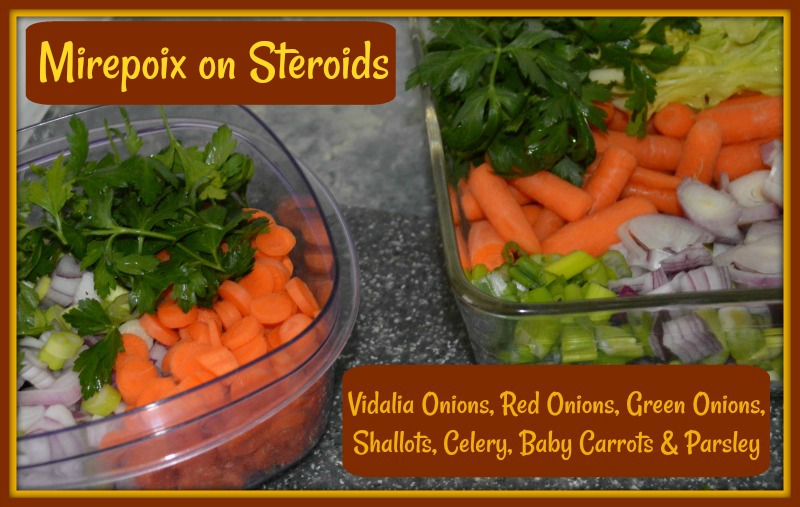It’s Thanksgiving week! The food prep can be overwhelming at time, but over the years I’ve found ways to make Thursday more enjoyable without breaking my back. I did ALL the shopping this morning and one of the first things I did was ALL the tedious chopping for my stuffing vegetables and gravy vegetables. I did a little research and found out I have been using a combination of several methods for years.  Mirepoix from the French is plainly diced vegetables cooked with butter (generally) on a gentle heat without browning until soft and flavorful. You are not trying to caramelize, but blend and sweeten the flavors to use as a base for other foods.
Mirepoix from the French is plainly diced vegetables cooked with butter (generally) on a gentle heat without browning until soft and flavorful. You are not trying to caramelize, but blend and sweeten the flavors to use as a base for other foods.
A traditional mirepoix is 2 parts onion, 1 part celery and 1 part carrots. This traditional base is then built and layered upon to enhance flavors for building stocks, soups, stews and sauces.
To make mirepoix: Rinse, trim, and peel vegetables — typically two parts onion to one part carrot and one part celery — then chop them into uniform pieces. The shorter the cooking time of your recipe, the smaller the pieces should be, so that they effectively infuse the foods with flavor.
There are of course different names and combinations of vegetables based on the culture. Similar flavor bases include:
- the Italian soffritto, The Italian version of mirepoix is called soffritto is a base of finely chopped parsley and onion sauted in lard, but most modern cooks substitute olive oil or butter. Garlic, celery, or carrot may also be included. According to the Italian restaurateur Benedetta Vitali, soffritto means “underfried” and describes it as “a preparation of lightly browned minced vegetables, not a dish by itself.”
- the Spanish sofito, There are many different versions of sofrito, but the basics are green and red peppers, onions, garlic, and cilantro.
- the Portuguese refogado. Refogado is a Portuguese-style sofrito featuring onion, garlic, saffron, tomato and smoked paprika.
- the German Suppengrün (leeks, carrots, and celeriac), means soup greens in German, and the Dutch equivalent is soepgroente. Soup greens usually come in a bundle and consists of a leek, a carrot, and a piece of celeriac. It may also contain parsley, thyme, celery leaves, rutabaga, parsley root, and onions. The mix depends on regional traditions, as well as individual recipes. The vegetables used are cold-climate roots and bulbs with long shelf lives. Suppengrün act as herbs and impart hearty, strong flavors to the soup or sauce, providing a foil for other strong tasting ingredients such as dried peas and beans or pot roast. Large chunks of vegetables are slow cooked to make flavorful soups and stocks, and are discarded when the vegetables have given up most of their flavor. Finely chopped Suppengrün are browned in fat and used as a basis for a finished sauce. The vegetables may also be cooked long enough until they fall apart, and may become part of the sauce or pureed to form the sauce.
- the Polish włoszczyzna (leeks, carrots, celery root, and parsley root), A typical set of soup greens, known as włoszczyzna, the Polish word for soup vegetables or greens and literally translates to “Italian stuff”, used in Polish cuisine: carrots, parsley root and leaves, leek, and celeriac. Bay leaves and allspice grains are also shown. Queen Bona Sforza, who was Italian and married Polish King Sigismund I the Old in 1518, introduced this concept to Poland. A włoszczyzna may consist of carrots, parsnips or parsley root, celery root or celeriac, leeks, and savoy or white cabbage leaves, and sometimes celery leaves and flat-leaf parsley.
- and here in the U.S. we use the standard mirepoix, the classic and most common French combination of onions, carrots, and celery, typically in a ratio of 2 parts onion to 1 parts each carrot and celery as well as the Cajun and Creole holy trinity that replaces the carrots in the standard mirepoix with bell peppers and sometimes the French duxelles (mushrooms and often onion or shallot and herbs, reduced to a paste).
Though the cooking technique is probably older, the term “mirepoix” dates from the 18th century and is credited to the chef, Charles Pierre Gaston Francois de Levis, duc de Levis Mirepoix who was the field marshall and ambassador and member of the noble family of Levis, lords of Mirepoix.

